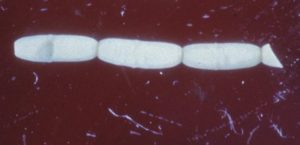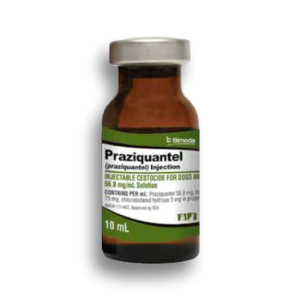Tapeworms are hardly a severe health risk, but they can cause itchiness and irritation to your dog. Therefore, it is vital to know how your dog contracts tapeworm, the signs/symptoms, and how to eventually get rid of the parasite.
You can buy Praziquantel de-wormer tablets here.
-
Product on sale
 Apicenna® Praziquantel Suspension Dewormer for Small and Large Breed Puppies and Dogs- 10 mlOriginal price was: $59.00.$49.00Current price is: $49.00.
Apicenna® Praziquantel Suspension Dewormer for Small and Large Breed Puppies and Dogs- 10 mlOriginal price was: $59.00.$49.00Current price is: $49.00.
What are Tapeworms?

Tapeworms are ribbon-like worms as adults. They are flatworm parasites that live in the intestines of their host. Usually dogs, cats, and other animals. The adult tapeworm has a scolex (head), a short neck, and a strobila (segmented body) formed of proglottids (a segment of the tapeworm containing both male and female reproductive organs). Mature proglottids are essentially bags of eggs shed into the surrounding environment to infect other hosts.
How does your dog contract Tapeworm?

The head of the tapeworm (called Scolex), which is normally a four-sided knob is armed with hooks and suckers. it uses to attach itself to the walls of your dog’s small intestine.
Tapeworms do not have a digestive system, instead, they absorb nutrients through the proglottids.
This series of segments are produced from the neck by mitotic growth, which is followed by transverse constriction, and they are linked together like a chain.
The parasite continuously grows new segments, with each segment become larger and more mature as they are displaced backwards by fresher segments.
Adult worms continue to add segments as long as they live. When mature, the segments produce hundreds or thousands of eggs, the larger and most mature segments farther from the scolex are then released through the faces of the dog into the immediate environment where they can be consumed by a host.
Premature worms must spend development time inside an intermediate host before being able to infest your dog. Dipylidium caninum and taenia species are the most common tapeworms.
The flea serves as an intermediate host for the former, while another vertebrate, often rodents serve as an intermediate host for the latter.
Your dog may likely have Pyridium tapeworms if it is infested with fleas. Flea larvae consume tapeworm eggs, which develop inside the flea as it matures. Your dog might swallow a flea and infect itself with tapeworm.
How can you tell if your dog has Tapeworms?

You observe your dog closely and notice the following:
- Irritability
- Licking of the anal area
- Skin is dry and flaky
- Dragging its anal region against the ground
- Dry, dull, and unkempt hair coat.
- Excessive weight loss despite regular food consumption.
- Increased appetite without any form of weight gain
- Visibility of segments of the worm in your dog’s feces like rice grains.
Treatment of Tapeworm
There are several medications for the treatment of tapeworm, but this must be carried out by your vet after carrying out proper tests and diagnosis. Although Praziquantel is a first-choice medication specifically designed for this purpose as a tapeworm dewormer.
Read through the following to know more about Praziquantel, its uses, benefits and downsides.
- What is Praziquantel?
- What are the uses of Praziquantel?
- The required dosage of Praziquantel to give your dog…
- How to administer praziquantel
- What are the side effects/downsides of Praziquantel?
- Is Praziquantel safe for your dog?
- How to properly store Praziquantel
- What other natural medications can I try?
- Warnings
- conclusion
What is Praziquantel?
Praziquantel tablets (tapeworm dewormer) brand (Droncit®) are designed specifically for the eradication of tapeworms from your dog’s body.
The tablets are sized for easy oral administration and can be administered to either puppies or adult dogs. This is an FDA approved drug for the treatment of tapeworms in dogs and cats.
Each tablet contains 34 mg praziquantel and you can crumble and mix with your dog’s feed for easy consumption.
What are the uses of Praziquantel?
Tapeworm Dewormer (praziquantel tablets) are designed for the removal of the common tapeworms, Dipylidium caninum and Taenia species, from adult dogs and puppies.
Praziquantel Dosage for Dogs
Below are the normally prescribed doses of praziquantel you can administer to your dog.
The dose to follow entirely depends on your dog’s body weight.
- 5 lbs. body weight and under, give ½ tablet.
- 6 to 10 pounds of body weight give 1 tablet.
- 11 to 15 pounds of body weight give 1½ tablets
- 16 to 30 pounds of body weight give 2 tablets
- 31 to 45 pounds of body weight give 3 tablets
- 46 to 60 pounds of body weight give 4 tablets
- 60 lbs. give 5 tablets at maximum.
It is always advisable to consult your veterinarian for assistance in the diagnosis, treatment, and control of parasitism.
How to administer Praziquantel
You may give this medication directly to your dog orally, or you may crumble the tablet(s) and mix it with its food.
Ensure to consult your veterinarian before administering the tablets to weak or unhealthy animals.
What are the Side Effects/downsides of Praziquantel?
Side effects are usually uncommon with this medication, but they may include lack of appetite diarrhea, drooling, or tiredness in dogs following treatment.
Most of the side effects were said to be mild and only lasting about 30 minutes to 4hours after treatment.
Do not use any medication without your vet’s recommendation and prescription.
Is Praziquantel Safe for your Dog?
Well, this medication is considered generally safe for dogs.
But there are some discussions you need to have with your vet before administering this medication because some of these factors might affect the efficacy of this medication in your pooch.
Make sure you discuss the following with your vet.
- Any other medications (including vitamins supplements or herbal therapies you give to your dog) as other drugs can affect the way this medication works.
- About any previous condition or diseases, your pet has had or currently has.
- If your pooch is pregnant or nursing
- Inform your vet if your pooch has been treated for the same disease in the past, and how well of success, or failure the treatment was.
How to Properly Store Praziquantel
Store this medication at a temperature at less than or equal to 25°C (77°F) in its original prescription bottle and protect it from direct sunlight.
You should also keep this medication away from the reach of children and other animals.
NOTE: take important steps to make sure that your environment is free from fleas and rodents. Otherwise, reinfection is almost certain to occur.
Should there be a case of reinfection, you may discover tapeworm segments may within one month of the initial treatment.
Warning
This medication is not for human use. Do not consume.
Also, ensure that you do not overdose your dog on this medication.
Do not give this medication to dogs that are less than 4 weeks of age, and dogs that are allergic to it.
What other Natural Remedies can you try?
There are many simple and effective remedies you can for the treatment of tapeworms in your dog. I will talk about some of the best ones below.
Garlic
The sulfur compounds and volatile oil in garlic make the intestinal walls less hospitable for tapeworms. Thus, the tapeworms are expelled from your dog’s body.
Garlic (although not often advised because of appropriate dosing concerns), is one of the best home remedies for the treatment of tapeworms in dogs. Although, you should feed garlic moderately to your dog. Additionally, ensure not to feed garlic to your dog if it is taking blood thinners.
The use of garlic should not exceed 1 week, as it could be harmful to your dog, leading to anemia and death. Administer the appropriate number of garlic depending on your dog’s body weight.
- 10 to 15 lbs. ½ clove
- 20 to 40 lbs. 1 clove
- 45 to 70 lbs. 2 cloves
Grate the required number of garlic and mix it with some fennel before feeding it to your dog.
Also, garlic is good for your dog’s immunity.
Pumpkin Seeds
Pumpkin seeds are said to be highly effective in the treatment of not just tapeworms, but also other intestinal parasites.
The seeds are rich in a natural deworming compound called cucurbitacin (an amino acid that expels tapeworms from your dog’s intestines). Additionally, this compound paralyzes the tapeworms, and then they are expelled from the digestive tract.
To administer, grind up pumpkin seeds and feed anything between ¼ – 1 teaspoon (depending on your dog’s body weight) of the powder to your dog before every meal. Also ensure not to feed in excess and do not use salted pumpkin seeds.
Carrots
Carrots remove the mucus from your dog’s intestinal walls which help expel the worms. Thus, serving the purpose of a dewormer. Also, carrots support your dog’s immune system.
Papaya
This contains an enzyme called papain that can help combat tapeworms. Other helpful remedies include; Coconut, Black Walnut Hulls, Wormwood.
Conclusion
As a dog parent, it is always a good feeling to see your paw friend healthy and happy. Tapeworms feed on the nutrients your dog is supposed to benefit from, and nobody wants this. Thus, you should be proactive in your approach towards combating tapeworms. It is also important to note that for most dogs, the dead worms are digested and may not be seen in the feces.
 Total Pooch Dog Supplements, Tear Stain Removers, De-wormers, Tylosin for Dogs and other great products.
Total Pooch Dog Supplements, Tear Stain Removers, De-wormers, Tylosin for Dogs and other great products.



